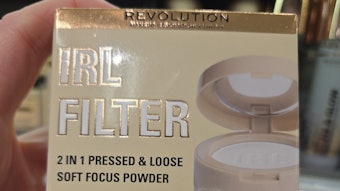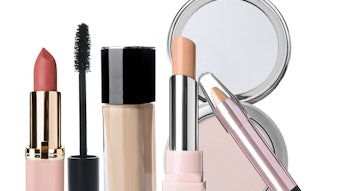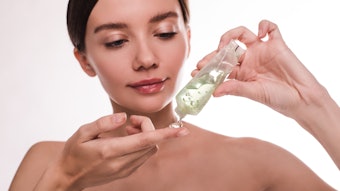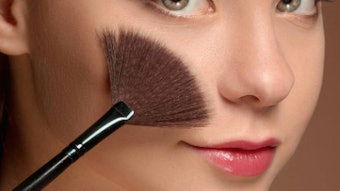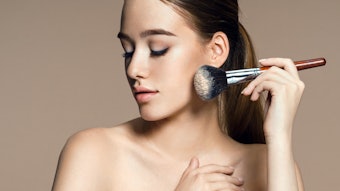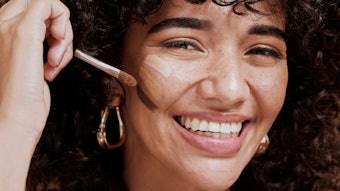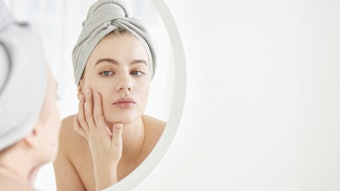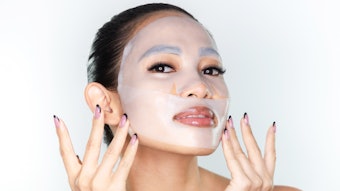Human evolution has favored alliances with healthy rather than unhealthy individuals, which is a trait shared with many other animal species.1 This state of health is often communicated visually; for example, the bright feathers of healthy male birds advertise to potential mates said male’s capability to invest precious energy in producing these details of beauty. In addition to communicating general health, studies2 concerning the faces of Caucasian females have shown that shape, symmetry and texture also are cues of attractiveness. In relation, color is perhaps one of the most important and variable characteristics of the face. Glowing pink, golden tones and silken luminosity transmit messages of health, youth and attractiveness.3 Rosy coloring on the cheeks, for example, can indicate the skin is adequately flushed with blood and oxygen, suggesting a strong heart and lungs. As time passes, these colors tend to equalize.
Log in to view the full article
Human evolution has favored alliances with healthy rather than unhealthy individuals, which is a trait shared with many other animal species.1 This state of health is often communicated visually; for example, the bright feathers of healthy male birds advertise to potential mates said male’s capability to invest precious energy in producing these details of beauty. In addition to communicating general health, studies2 concerning the faces of Caucasian females have shown that shape, symmetry and texture also are cues of attractiveness. In relation, color is perhaps one of the most important and variable characteristics of the face. Glowing pink, golden tones and silken luminosity transmit messages of health, youth and attractiveness.3 Rosy coloring on the cheeks, for example, can indicate the skin is adequately flushed with blood and oxygen, suggesting a strong heart and lungs. As time passes, these colors tend to equalize.
One potential connection between health and color could be made from golden and orange tones to the carotenoid pigments found in fruits and vegetables. The brain may instinctively perceive individuals wearing these colors as having strong immunity to recover from illness, are well-nourished and full of antioxidant defenses to protect against free radicals. Such connections might explain why many women are drawn to using color to modify their face, cheeks and lips.4 This article considers color formulations, including stains and blushes designed for the very specific cheek area.
Formula Functions and Requirements
Cheek stains and blushes are intended for a lightly shaded color that does not hide the underlying skin tone. In fact, the natural cheek color should blend with that of the applied stain to provide a transparent hue, giving skin a natural, fresh and glowing look. One additional function and important reason for applying this category of products is to modify light and shadows on the center of the face; i.e., enhancing some parts and hiding light imperfections.
For these reasons, formulations must exhibit key requirements such as imparting a layer as thin as watercolor and providing color that is easily shaded. Also, the color should be substantive to skin, long-lasting, and sweat- and kiss-resistant. It should also blend well with successive overlays of other transparent makeup products and be easy enough to completely remove. Consequently, the related formula parameters include traits such as being pigmented; easy to apply, shade and remove; sebum-compatible; and moisture proof. While color cosmetics apply an adhesive film to the skin surface, they must also be elastic and plastic enough to follow skin movements. Finally, the formulations preferably provide long-lasting, transparent color.
Clearly, all these requirements for recipes could be modulated according to several formulation schemes. One could develop a light, watercolor-inspired formula based on aqueous gels. There is also the abundant category of cast products—i.e., stick-shaped or otherwise cast into some type of container—as well as the huge category of loose and pressed powders. Finally, one could formulate fluid oil gels, which usually are filled in small bottles shaped liked sticks and having soft sponge applicator tips.
Pigments
Most pigments traditionally used in standard makeup can be incorporated into cheek products; i.e., iron oxides and lakes. Red-shaded lakes and ocher are the most prevalent in cheek products. Very fine synthetic pearls, such as those made from titanium dioxide deposited on mica and the like, are also used. One inconvenience of insoluble pigments is their opacity, which hides the underlying skin surface. Thus, the dimensions of the pigment particles and their aggregates are important. Extreme subdivision through adequate milling is required in order to impart transparency, as is using low amounts. Wet-milling is the preferred operation for pigment dispersion, as it surrounds each particle with a wetting vehicle and avoids re-aggregation.
However, pigments and pearls can be easily rubbed from the skin, which is why, in cases where long-lasting color is desired, so-called staining colorants are used. These are substantive to skin keratin, and form an indelible, transparent, colored mono-molecular film that resists abrasion and contact with other surfaces. Initially, until World War I in 1914, carmine dye was used. Also called cochineal red, it was derived from the Coccus cacti, or cochineal insect although today it is simply reproduced biochemically. While it is insoluble, it can be easily solubilized by neutralizing it with a small amount of alkali, such as dilute sodium hydroxide. The advantage of this method is that once the solution is applied to skin, the acidity of the hydro-lipidic film on the skin surface induces a precipitation of the colorant on-site, which makes the trace more wear-resistant.
Bromo acids like fluoresceins, brominated fluoresceins and other related water-insoluble dyes are also used. These can be divided into two groups according to the color they impart on skin—i.e., red with a reddish blue stain or orange-red, which imparts a yellow to pink shade. The degree of staining depends on the amount of pigment and choice of solvent used to dissolve the pigment—and how completely the pigment is dissolved. The amount of dye is usually around 2–3%.5 Formula 1 provides an explanatory, traditional example of a combined approach utilizing pigments and staining colorants.
Commercial Examples and Discussion
Besides commonly used oil vehicles, light emulsions can be employed, and are similar in composition to eye liner but with less oil phase and with additional skin wetting emulsifiers and hydrotropes. The first two examples come from Tarte Cosmetics.6 In addition, in most of the examples shown here, note the frequency of using pomegranate extract—which is used for at least two reasons: one, the antioxidant polyphenols it contains are very good anti-aging ingredients; two, the extract typically has a pink color, which blends well with the other dyes in the formulas.
Example 1: Propylene glycol, aqua, nonyl nonoxynol-150, glycerin, sodium stearate, laureth-23, stearic acid, Lycium barbarum fruit extract, Euterpe oleracea fruit extract, Malpighia punicifolia (acerola) fruit extract, Punica granatum extract, Passiflora incarnata fruit extract, polyvinylpyrrolidone (PVP), parfum/fragrance (natural). May contain (+/-): Mica, bismuth oxychloride, titanium dioxide, iron oxides, carmine (CI 75470), red 33 (CI 17200), red 40 (CI 16035), yellow 5 (CI 19140) blue 1 (CI 42090).
This example is a stearic emulsion, evidently rich in the emulsifiers/surfactants sodium stearate and nonyl nonoxynol-150 that also are working as skin-wetting agents associated with the film-forming effect of PVP. Vegetal extracts are added for skin benefits. Here, a combination of insoluble pigments and staining colorants has been adopted. In this type of emulsion, an excess emulsifier is needed in order to thoroughly wet the pigments. One should consider that stearic emulsions, when applied to the face, undergo a sudden change in pH due to skin’s acidity. This action reduces the total amount of emulsifiers and, in doing so, provides water resistance. Moreover, stearic acid forms an adhesive layer on the skin surface, which holds the pigments in place.
Example 2: Helianthus annuus (sunflower) seed oil, Ricinus communis (castor) seed oil, hydrogenated castor oil laurate, Candelilla cera, Cera carnauba, Butyrospermum parkii (shea butter), rice bran wax, glyceryl oleate, trihydroxystearin, Carthamus tinctorius (safflower) seed oil, parfum/fragrance (natural), caprylyl glycol, Vitis vinifera (grape) seed oil, tocopheryl acetate, Lycium barbarum fruit extract, Euterpe oleracea fruit extract, Malpighia punicifolia (acerola) fruit extract, Punica granatum extract, Passiflora incarnata fruit extract. May contain (+/-): Carmine (CI 75470), iron oxides.
This example is suitable for a cast product, and evidently is a lipid blend with a fully vegetal-derived profile. Vegetal oils are thickened by trihydroxystearin, hydrogenated castor oil laurate and vegetal waxes. Caprylyl glycol is included for improving the solubility of the carmine color. Except for the abundance of vegetal oils, this formula is comparable to typical makeup products.
Example 3: Triisostearyl citrate, Olea europaea (olive) fruit oil, Persea gratissima (avocado) oil, Cucurbita pepo (pumpkin) seed oil, beeswax, Simmondsia chinensis (jojoba) seed oil, Punica granatum (pomegranate) extract, Rubus fruticosus (blackberry) fruit extract, Vaccinium angustifolium (blueberry) fruit extract, Vaccinium macrocarpon (cranberry) fruit extract, Camellia sinensis (white tea) leaf extract, Carthamus tinctorius (safflower) seed oil, Rosa damascena flower wax, tocopherol, ascorbyl palmitate, citric acid. May contain (+/-): Red 21 (CI 45380) [also known as red 223].
This fluid formula, in the shade “Forever Pink,” from Jane Iredale7 is described as being suitable for vegans, and it is gluten-free. The staining effect is due to red 21, a bromo acid well-known for skin-staining. Tri-isostearyl citrate is a good solvent for this moderately soluble ingredient; the solubility of stain is necessary for an equilibrated effect. Citric acid is added as a sequestering aid to avoid oxidation of lipids and to immediately provide a low pH when the product contacts skin moisture, making the staining more efficient. This product is in a soft stick format.
Example 4: Water (aqua), glycerin, butylene glycol, sodium carbomer, trisodium EDTA, flavor (aroma), fragrance (parfum), potassium sorbate, sodium hyaluronate, phenoxyethanol, riboflavin, tocopheryl acetate, ascorbic acid, Prunus avium (sweet cherry) fruit extract, propylene glycol, Punica granatum extract, red 33 (CI 17200), yellow 6 (CI 15985), green 5 (CI 61570), red 22 (CI 45380).
From previous examples, the formulation strategy changes completely for this “Cherry Crush” lip and cheek stain from Stila.8 Here, red 22 stain, which has the same basic structure as red 21, and all dyes and pigments are dispersed in an aqueous vehicle. The wetting agents glycerin, butylene and propylene glycol are used—as are suitable preservatives, a well-known moisturizer and sodium hyaluronate. Carbomer provides the right viscosity in this blend, and since no evident emulsifier appears, it also is likely used as a polymeric emulsifier.
Example 5: Water, glycerin, propylene glycol, sorbitol, polysorbate 80, PEG 150, phenoxyethanol, flavor, PVP, potassium sorbate, triethanolamine, acacia gum (Acacia senegal) extract, methylparaben, ethylparaben, ammonium glycyrrhizate, benzophenone 4, sodium saccharin, propylparaben, sodium hyaluronate (hyaluronic acid). May contain (+/-): Yellow 5 lake, red 33 (CI 17200), blue 1 lake (CI 42090), yellow 6 aluminum lake (CI 15985), red 40 lake (CI 16035).
This Cover Girl lip stain demonstrates how lip and cheek stain categories can overlap, as they are based on the same formulation technology.9 This formula uses an aqueous gel thickened by acacia gum, with both hydrophilic emulsifiers and wetting agent to moisturize the skin via hyaluronic acid. Color is protected from sunlight with benzophenone-4. No staining colorants are used in this case, and the sweeteners saccharine and ammonium glycyrrhizate are introduced to make the formula pleasant for use on the lips.
Example 6: Aqua, glycerin, phenoxyethanol, panthenol, acrylates/C10-30 alkyl acrylate crosspolymer, methylparaben, aminomethyl propanol, CI 17200.
To complete the possible “universe” of physical forms and vehicles, The Body Shop offers this aqueous dispersion10 of a pigment in a very simplified vehicle. Here, the carmine acid is dissolved by the organic alkali aminomethyl propanol, panthenol provides skin moisturization properties and the polymeric emulsifier keeps everything homogenous. This formula will also incorporate skin sebum once applied, and the skin’s acidity will improve the color of carminic acid.
Example 7: Aqua, polysorbate 20, phenoxyethanol, sodium hydroxide, carmine (CI 75470) perfume, parabens, BHT, EDTA.
Lastly, Benefit strips cosmetics down to the essential in this example.11 One surfactant/wetting agent/emulsifier (polysorbate 20) is used—as is a preserving, sequestering, antioxidant system and carmine dissolved in alkali. Over all, this very basic structure could easily be the base for many variants.
New Ingredients
Since no new staining colorants have been launched in years, most research has sought ways to increase the permanence of pigments on the skin. One seriesa of polymers, for example, has been developed to increase wear and water-resistance, and a transfer-resistant, highly cross-linked trimethylsiloxysilicateb has been designed—and at 3-6%, this material is said to reduce pigment transfer in decorative cosmetics. In addition, polyphenylsilsesquioxanec, a film-former, has been introduced with a higher gloss than standard silicone resins. The solvent isopentyldiold improves the application performance of cast products; at levels of 2-3%, it boosts shine and pay-off while providing a softer feel. Also, a new ester from palm oil, isoamyl laurate,12 enables the preparation of concentrated dispersions of pigments with exceptional solids content—from 40% to 60% powder load, compared with the usual 20% to 40%. Finally, Abyssinian oile has been reported to provide good pigment dispersion properties, avoiding agglomeration.
Future Outlook
Makeup products are always on the move and subjected to the influence of a myriad of trends, and this holds true for cheek stains. One example is color formulas incorporating functional actives to nourish, protect and maintain skin hydration. The rationale behind this is that long-lasting color should be accompanied by long-lasting efficacy in supporting and promoting the skin equilibrium and promoting/protecting skin health. This is especially important for the cheeks—among the most delicate and exposed areas of the face.
Among the trends, cheek stains and blushes are being applied beyond cheeks and stretched as a band across the face. Thus, in order to make application easier, the market will offer transfer sheets onto which a thin layer of product has been distributed. By applying the sheet across the cheeks, users transfer the color trace immediately and all at once, making application mistake-proof.
In relation, consumers might envision a future of applying a perfect makeup “glove” onto the face at the same speed and with the same ease as one pulls on gloves. Studies are being carried out to solve the most complicated aspects of such products to determine the “right” application for end users. Perhaps a computer-driven distributor will be the application problem-solver?
In the future, nano pigments will impart a natural, velvety look to skin. And though the stabilization of vegetal colorants from fruits and leaves has been difficult, polymeric skin-substantive sponges could enable the use of these colorants and allow for long-sought “natural colorant” claims. Finally, current research on illuminants and new coated pigments could inspire the creation of formulae that automatically adjust their intensity and color according to the type of illumination, i.e., natural daylight, neon lamps or candles. For the disco nights, vibrant colors that change their hue with changing body temperature would also be interesting.
References
- livescience.com/5860-attractiveness-based-partly-skin-color.html (Accessed Dec 2, 2013)
- www.sciencedaily.com/releases/2011/01/110111133224.htm (Accessed Oct 5, 2013)
- www.ncbi.nlm.nih.gov/pubmed/2335885 (Accessed Oct 5, 2013)
- ID Stephen, V Coetzee and DI Perrett, Carotenoid and melanin pigment coloration affect perceived human health, Evolution and Human Behavior (2010)
- N Board, Modern Technology of Cosmetics, Asia Pacific Business Press Inc., Delhi, India (2004)
- http://tartecosmetics.com/tarte-item-cheek-stain (Accessed Dec 10, 2013)
- https://janeiredale.com/us/en/mineral-makeup/lips/just-kissed-lip-and-cheek-stain.htm (Accessed Dec 10, 2013)
- www.stilacosmetics.com/product/cherry-crush-lip-%26-cheek-stain.do (Accessed Oct 10, 2013)
- www.covergirl.com/lip-makeup/lipstick/outlast-lip-stain (Accessed Oct 12, 2013)
- www.thebodyshop.co.uk/make-up/lips/lip-and-cheek-stain.aspx (Accessed Oct 12, 2013)
- www.benefitcosmetics.com/product/view/benetint (Accessed Oct 12, 2013)
- www.accessdata.fda.gov/scripts/cdrh/cfdocs/cfCFR/CFRSearch.cfm?CFRPart=172&showFR=1 (Accessed Oct 12, 2013)
